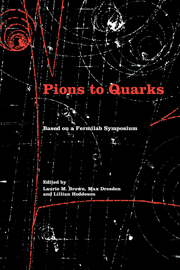Book contents
- Frontmatter
- Contents
- List of contributors
- Foreword by Leon M. Lederman
- Editors' acknowledgments
- Photographs of the symposium
- List of abbreviations
- List of notation
- I Introduction
- II Particle discoveries in cosmic rays
- III High-energy nuclear physics
- IV The new laboratory
- V The strange particles
- VI Weak interactions
- VII Weak interactions and parity nonconservation
- VIII The particle physics community
- IX Theories of hadrons
- X Personal overviews
- 45 Scientific impact of the first decade of the Rochester conferences (1950–1960)
- 46 Some reflections on the history of particle physics in the 1950s
- 47 Progress in elementary particle theory, 1950–1964
- Name index
- Subject index
47 - Progress in elementary particle theory, 1950–1964
Published online by Cambridge University Press: 07 May 2010
- Frontmatter
- Contents
- List of contributors
- Foreword by Leon M. Lederman
- Editors' acknowledgments
- Photographs of the symposium
- List of abbreviations
- List of notation
- I Introduction
- II Particle discoveries in cosmic rays
- III High-energy nuclear physics
- IV The new laboratory
- V The strange particles
- VI Weak interactions
- VII Weak interactions and parity nonconservation
- VIII The particle physics community
- IX Theories of hadrons
- X Personal overviews
- 45 Scientific impact of the first decade of the Rochester conferences (1950–1960)
- 46 Some reflections on the history of particle physics in the 1950s
- 47 Progress in elementary particle theory, 1950–1964
- Name index
- Subject index
Summary
I should like to begin by expressing regret for not having been able to be present for the last Fermilab meeting, at which I had been asked to give the final talk about what it was like to be a student of theoretical physics in the late forties, the end of the period covered by that meeting. I still hope to present that material somewhere. Between that conference and this one there were two others, one in Paris in the summer of 1982, where I gave a talk about my experiences with strangeness, and one in 1983, in Sant Feliu de Guíxols in Catalunya, where I spoke on the subject “Particle Theory from S-Matrix to Quarks.” That second conference was called a “trobada” in the Catalan language, a word that reminds us of the troubadours of the Middle Ages who flourished in Catalunya. It reminds us also that we have become much like those medieval minstrels. We spend a great deal of time now traveling from one orgy of reminiscence to another, each one held in the capital of some princely state. Here I am helping to close another “trobada.”
Let me repeat something I said in Catalunya: I shall once again commit the sin of hindsight in the eyes of some of those historians of science who come from the historical tradition.
- Type
- Chapter
- Information
- Pions to QuarksParticle Physics in the 1950s, pp. 694 - 712Publisher: Cambridge University PressPrint publication year: 1989
- 4
- Cited by



